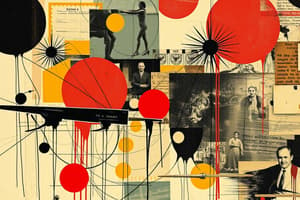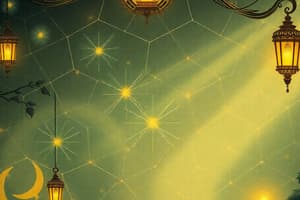Podcast
Questions and Answers
What is the primary result of the aesthetic function of art?
What is the primary result of the aesthetic function of art?
- It leads to a conscious appreciation of beauty. (correct)
- It encourages a deeper understanding of cultural heritage.
- It provides practical tools for daily living.
- It fosters international cooperation.
Which function of art is associated with providing comfort and necessities of life?
Which function of art is associated with providing comfort and necessities of life?
- Aesthetic function
- Utilitarian function (correct)
- Social function
- Cultural function
Which function of art emphasizes the transmission of cultural skills and knowledge across generations?
Which function of art emphasizes the transmission of cultural skills and knowledge across generations?
- Social function
- Cultural function (correct)
- Utilitarian function
- Aesthetic function
In what way does the social function of art impact relationships among nations?
In what way does the social function of art impact relationships among nations?
How does the utilitarian function of art enhance daily living?
How does the utilitarian function of art enhance daily living?
What does the Latin word 'ars', from which the term art is derived, primarily refer to?
What does the Latin word 'ars', from which the term art is derived, primarily refer to?
Which of the following is NOT considered an essential of art?
Which of the following is NOT considered an essential of art?
According to C. Sanchez, what is a key function of art?
According to C. Sanchez, what is a key function of art?
Which statement reflects John Dewey's perspective on art?
Which statement reflects John Dewey's perspective on art?
What does F. Zulueta suggest is a fundamental aspect of art?
What does F. Zulueta suggest is a fundamental aspect of art?
Which of the following definitions of art emphasizes its relationship to beauty?
Which of the following definitions of art emphasizes its relationship to beauty?
What concept does the scope of art cover?
What concept does the scope of art cover?
What aspect is emphasized as a crucial characteristic of art?
What aspect is emphasized as a crucial characteristic of art?
Which of the following is categorized as a practical art?
Which of the following is categorized as a practical art?
Which of the following is NOT considered a visual art?
Which of the following is NOT considered a visual art?
What distinguishes fine arts from practical arts?
What distinguishes fine arts from practical arts?
Which category includes activities like city physical planning and interior arrangement?
Which category includes activities like city physical planning and interior arrangement?
Which of the following best represents the concept of liberal arts?
Which of the following best represents the concept of liberal arts?
What are minor arts primarily characterized by?
What are minor arts primarily characterized by?
Which of the following types of art focuses specifically on useful applications?
Which of the following types of art focuses specifically on useful applications?
Which of the following is NOT typically classified under graphic arts?
Which of the following is NOT typically classified under graphic arts?
What distinguishes kinetic arts from other forms of art?
What distinguishes kinetic arts from other forms of art?
Which is a notable characteristic of phonetic arts?
Which is a notable characteristic of phonetic arts?
Which type of arts incorporates more than one medium?
Which type of arts incorporates more than one medium?
What is the main purpose of plastic arts according to the classification?
What is the main purpose of plastic arts according to the classification?
In what form do pure arts typically take expression?
In what form do pure arts typically take expression?
Which of the following best describes the historical aspect of indigenous art?
Which of the following best describes the historical aspect of indigenous art?
Which of the following arts is most likely to include elements such as singing and dancing?
Which of the following arts is most likely to include elements such as singing and dancing?
What is a common misconception about pure arts?
What is a common misconception about pure arts?
Flashcards are hidden until you start studying
Study Notes
Meaning and Importance of Art
- Art is a complex concept with various meanings and influences human life significantly.
- The term "art" originates from the Latin "ars," meaning "ability or skill," and the Italian "artis," signifying craftsmanship and mastery.
- Art encompasses various disciplines like music, sculpture, painting, literature, dance, drama, architecture, and film.
- Art serves both aesthetic and utilitarian functions, providing beauty, comfort, and solutions to practical needs.
- Art appreciation involves understanding and enjoying man-made art forms, either through hands-on experience or admiration.
The Subject of Art
- Each art form has a subject matter that serves as the foundation of creation.
Function of Art
- Art's aesthetic function makes us aware of the beauty of nature, enriching life with its own creation and the works of others.
- Art's utilitarian function provides essential necessities like shelter, clothing, food, light, and medicine, contributing to comfort and happiness.
- Art functions culturally to transmit knowledge and skills across generations, preserving cultural heritage and fostering awareness of one's background.
- Art serves a social function by promoting unity and cooperation through various forms of art like civic and graphic art.
Scope of Art
- Art broadly encompasses fine arts (aesthetic) and practical arts (useful).
- Fine arts include music, painting, sculpture, architecture, literature, dance, and drama.
- Practical arts include industrial art, applied or household arts, civic art, commercial art, graphic art, agricultural art, business art, distributive art, and fishery art.
Visual Arts
- Visual arts are classified into graphic and plastic arts.
- Graphic arts encompass painting, drawing, photography, graphic processes (printing), commercial art (designing books, advertisements, etc.), and mechanical processes, portraying forms and symbols on a two-dimensional surface.
- Plastic arts consist of all visual arts where materials are organized into three-dimensional forms, including structural architecture, landscape architecture (gardens, parks, etc.), city planning, interior design, sculpture, crafts, industrial design, costume design, and theater design.
Arts Classified by Purpose
- Practical or useful arts are directed towards creating artifacts and tools to fulfill human needs. Examples include handicrafts (basket weaving, embroidery), ceramics, metal crafts, and manufacturing.
- Liberal arts focus on intellectual growth through the study of philosophy, psychology, literature, mathematics, and sciences.
- Fine arts concentrate on creative activity for contemplation and spiritual upliftment. Examples include painting, sculpture, and architecture.
- Major arts are distinguished by their expressiveness, such as music, poetry, and sculpture.
- Minor arts are concerned with practical uses and purposes like interior decoration and porcelain art.
Arts Classified by Media and Forms
- Plastic arts create works that exist in physical space, perceived by the sense of sight. Examples include sculpture and decorative materials.
- Kinetic arts involve rhythm as a medium of expression, such as dance.
- Phonetic arts utilize sounds and words for expression. Examples include music, drama, and literature.
- Pure arts use only one medium of expression, such as sound in music or color in painting.
- Pure arts can also combine multiple mediums, such as opera, which incorporates music, poetry, and drama.
The Origin of Art
- The history of art dates back to the time when humans relied on superstitions and beliefs.
- Art began as a form of communication and expression of these beliefs, particularly through dancing, painting, music, and rituals.
- These early forms of art were performed during ceremonies, often to entertain, appease, and worship deities.
Studying That Suits You
Use AI to generate personalized quizzes and flashcards to suit your learning preferences.




